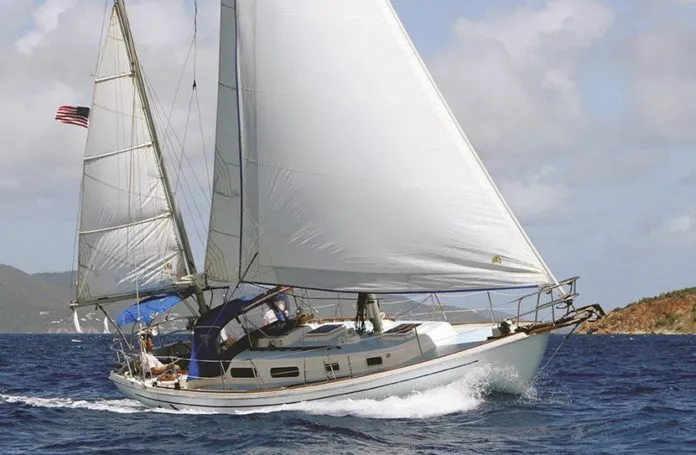This week I had the opportunity to poke around a ketch-rigged Pearson 424 that was for sale in the neighborhood, and although they’ve generally fallen out of favor today, I was reminded of the many advantages of the ketch design. The Pearson 424 is an example of several decades-old production boats that were offered in a variety of rigs (sloop, cutter, or ketch), which has given longtime owners an opportunity to compare sail plans.
Judging from Pearson 424 list prices and bulletin board discussions about the Pearson 424, it appears that the scales are slightly tilted in favor of the sloop and cutter versions. However, the ketch owners are equally emphatic regarding their boats’ positive attributes. Having covered most of my cruising miles aboard a ketch, I’m an impartial party in this debate. So keep in mind, that much of what you read below (redacted from an earlier post of mine) is colored by personal experience.
My affinity for cruising ketches like the Allied Seawind II we feature in the January 2016 issue of Practical Sailor runs contrary to the view of their many detractors. Their criticism goes something like this: Ketches were popular in early days of cruising when undersized winches and friction-bound hardware conspired to make handling large sails a chore. With efficient winches and modern hardware, split rigs are obsolete on boats under 50 feet, they say.
Having wrestled down the main on more than a few 40-footers with state of-the-art everything, I don’t buy this argument, but I’ll let it stand. Nor will I quibble over complaints about a ketchs handicap to windward-which in my view is overstated, at least with regards to the better designs. Being the first boat to reach a windward watering hole is nice, but it’s hardly the first feature you look for in a good cruising boat.
You can explore the cruising blogosphere and find plenty of resident ketch-haters, and indeed, some of the complaints have merit; the added weight and expense of the ketchs extra rigging are irrefutable knocks. But having lived aboard and sailed a much-beloved, 32-foot William Atkin ketch for 10 years, I’m not interested in joining the chorus. Instead, I celebrate the rigs attractions, especially to the short-handed cruiser.
- Smaller sails are easier to handle. In squally weather, start with a reef tucked in the main, then just furl the mizzen or jib as needed without leaving the cockpit, upsetting helm, or wrestling more reefs into the main.
- Ride the invisible rail. The fore-and-aft distribution of sails simplifies the task of achieving a rock-steady helm.
- Impress your sloop-sailing friends with fancy ketch tricks. Sail backward through the mooring field (spin circles if you have a sharpie), nose casually up to anchor, hove-to with jig and jigger.
- Barrel westward on a reach. Turbo-charge off-wind sailing by setting a mizzen staysail.
- Don’t fear a dismasting. Having two independently stayed masts increases your odds of having at least one spar to use for jury rigging. (This advantage does not apply to ketches with triatic stays like the lovely Sea Witch.)
- Sail in good company. Some famous ketches to consider: Steinlager 2 (1990 Whitbread winner), Suhaili (Robin Knox Johnstons Golden Globe race winner), Joshua (Bernard Moitessiers beloved, steel globe-trotter), Wanderer IV (Eric and Susan Hiscocks storied cruiser), Colin Archers heroic little rescue boats . . . the list goes on.
- Draw longing sighs from those ashore. There is something about having a main and mizzen working together that kindles romantic visions of South Sea islands.
Another nice thing about ketches is that many have reached an age when they are true bargains. Here are just a few familiar ketches worth considering:
L. Francis Herreshoffs classic H-28, Gary Hoyts unstayed Freedom 40, Charlie Morgans family-friendly Bahama-mama Out Island 41, Ted Brewers Whitby 42 (aka Brewer 12.8), the Cheoy Lee Offshore 41, any of William Gardens iconic ketches, the Swedish-built Hallberg-Rassy 42, Atkins Ingrid 38 (and her related offspring), John Hannas iconic Tahiti ketch, Holman & Pyes Bowman 57, and two S&S designs, the Swan 57 and Tartan TOCK.
These are just a few that come to mind. I’m sure PS readers have many other boats to add to the list as evidence that reports on the death of the cruising ketch have been greatly exaggerated.



































